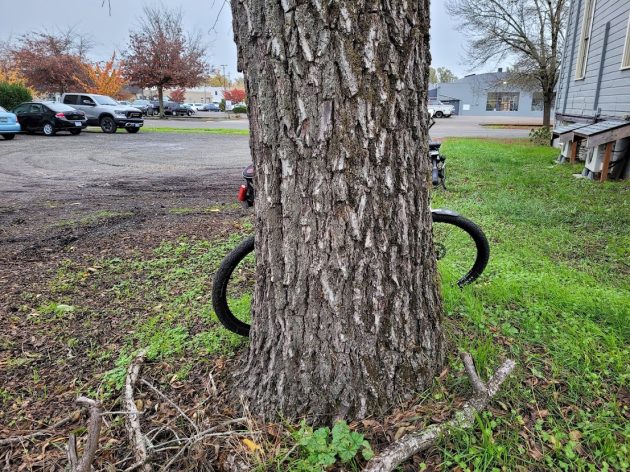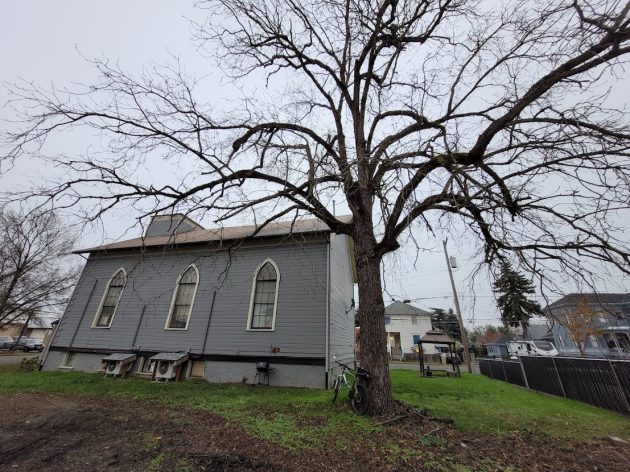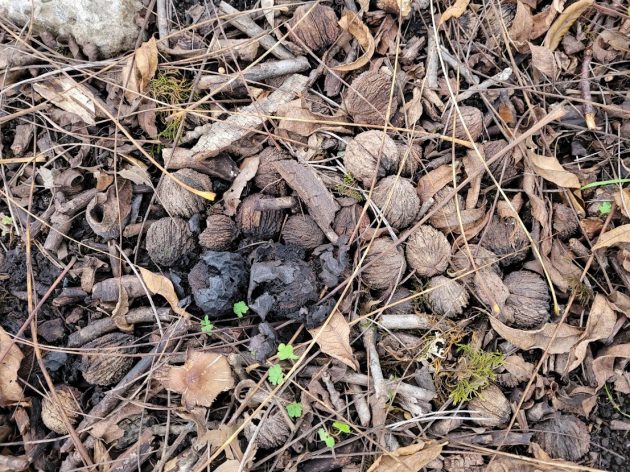
That walnut at 238 Third Ave. S.E. is big, but not big enough to hide a bike behind.
That big old black walnut tree at the back of a vacant lot in Albany is destined to be cut down, but on Nov. 10 it was still there, so I thought I’d take another photo or two.
The lot is at 234 Third Ave. S.E., between the Wood Apartments (the former Labor Temple building) on one side and, on the other, what’s left of one of Albany’s first churches. The Scott Lepman Company has plans to build eight townhouses on the property, and the tree is in the way of that.
The walnut in the southeast corner of the lot measures 28 or 29 inches in diameter at breast height. Whether it could or should be preserved was one of the points of discussion when a site plan for the development came before the Albany Planning Commission this summer.
At first, the commission rejected the townhouse plan based partly on the tree issue. But then it developed that felling trees or not felling them was not a proper criterion for that kind of land use decision. And at a second meeting, the commission approved the plan. The action was summarized in a story here.
On the city’s website page of building permits, an Oct. 27 entry lists a permit to remove the tree, along with a notation saying “application created.”
I wasn’t able to reach anyone at the development company on when it plans to start construction. Whenever it does, the tree presumably will come down first.
Once the townhouses are built, maybe something will eventually be done with the historic church next door, whose steeple has long since been removed.
Albany’s inventory of historic places lists the building as the Methodist Episcopal Church built in 1875. It’s owned by CHANCE, the regional nonprofit recovery organization, which used it as its headquarters before moving across the street and a block west.
If they’ve decided what to do with the old church once it has three-story townhouses as neighbors, I haven’t heard what that is. (hh)

The doomed walnut next to the old former church, built in 1875, on Nov. 10.

On the ground below the tree, what you would expect: black walnuts.

Removing a tree because it’s “in the way” is disgusting. When these “planners” negotiate new building, it should be required to work around these sensational trees. It can be done. Just stop being lazy and figure out how to.
It’s terrible to see that they’re removing 11 trees in the project on Gibson Hill. The trees are all inline and would “break up” the unsightly wall to wall houses.
They’ll never bring back the beauty and majesty of those trees.
Thank you. This time I agree with you (with minor exceptions, of course). Wanted to write much more … no time.
“”” It can be done. Just stop being lazy and figure out how to.”””
Excellent attitude in many situations.
What’s all the hubbub about. Looks like a whole armory worth of rifle stocks to me. Black Walnut is expensive and I’ll be darned if it went to waste. That tree has had a buyer if not eyes on it for awhile.
Lazy, slacker arboristas! This is a slippery slope which, if one follows the logic, would eventually become over-cutting of the trees in Southern Oregon forests. Those who profess to understand the growth of our beloved forests should be equally versed in the problems associated with excessive slash and burn forestry. Knowledge is power.